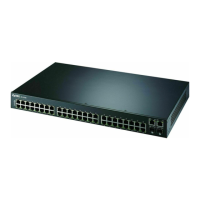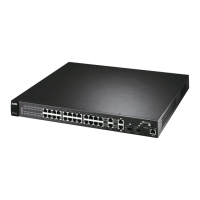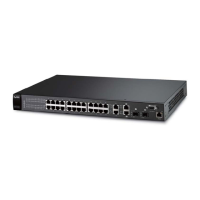Chapter 21 Multicast
ES-2024 Series User’s Guide
146
* Settings in this row apply to all ports.
Use this row only if you want to make some settings the same for all ports. Use
this row first to set the common settings and then make adjustments on a port-by-
port basis.
Note: Changes in this row are copied to all the ports as soon as
you make them.
Immed. Leave Select this option to set the Switch to remove this port from the multicast tree
when an IGMP version 2 leave message is received on this port.
Select this option if there is only one host connected to this port.
Normal Leave Enter an IGMP normal leave timeout value (from 200 to 6,348,800) in miliseconds.
Select this option to have the Switch use this timeout to update the forwarding
table for the port.
This defines how many seconds the Switch waits for an IGMP report before
removing an IGMP snooping membership entry when an IGMP leave message is
received on this port from a host.
Fast Leave Enter an IGMP fast leave timeout value (from 200 to 6,348,800) in miliseconds.
Select this option to have the Switch use this timeout to update the forwarding
table for the port.
This defines how many seconds the Switch waits for an IGMP report before
removing an IGMP snooping membership entry when an IGMP leave message is
received on this port from a host.
Group Limited Select this option to limit the number of multicast groups this port is allowed to join.
Max Group Num. Enter the number (0-255) of multicast groups this port is allowed to join. Once a
port is registered in the specified number of multicast groups, any new IGMP join
report frame(s) is dropped on this port.
Throttling IGMP throttling controls how the Switch deals with the IGMP reports when the
maximum number of the IGMP groups a port can join is reached.
Select Deny to drop any new IGMP join report received on this port until an
existing multicast forwarding table entry is aged out.
Select Replace to replace an existing entry in the multicast forwarding table with
the new IGMP report(s) received on this port.
IGMP Filtering
Profile
Select the name of the IGMP filtering profile to use for this port. Otherwise, select
Default to prohibit the port from joining any multicast group.
You can create IGMP filtering profiles in the Multicast > Multicast Setting >
IGMP Filtering Profile screen.
IGMP Querier
Mode
The Switch treats an IGMP query port as being connected to an IGMP multicast
router (or server). The Switch forwards IGMP join or leave packets to an IGMP
query port.
Select Auto to have the Switch use the port as an IGMP query port if the port
receives IGMP query packets.
Select Fixed to have the Switch always use the port as an IGMP query port.
Select this when you connect an IGMP multicast server to the port.
Select Edge to stop the Switch from using the port as an IGMP query port. The
Switch will not keep any record of an IGMP router being connected to this port.
The Switch does not forward IGMP join or leave packets to this port.
Apply Click Apply to save your changes to the Switch’s run-time memory. The Switch
loses these changes if it is turned off or loses power, so use the Save link on the
top navigation panel to save your changes to the non-volatile memory when you
are done configuring.
Cancel Click Cancel to begin configuring this screen afresh.
Table 44 Advanced Application > Multicast > Multicast Setting (continued)
LABEL DESCRIPTION

